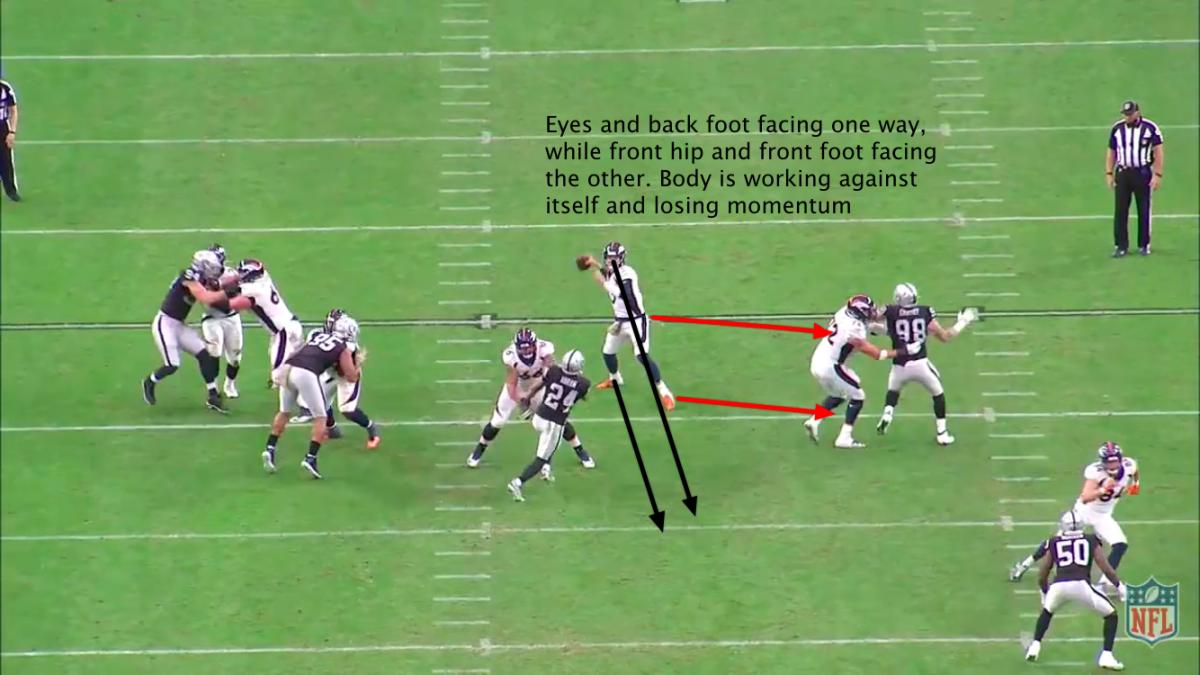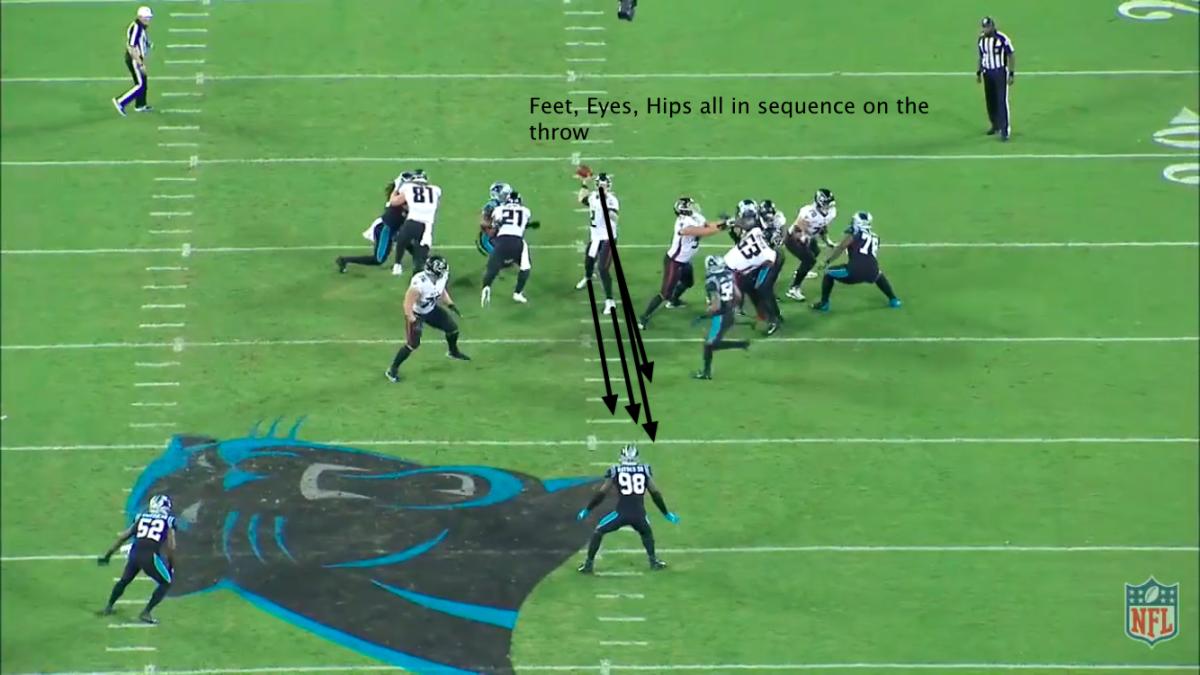The Mechanics of Drew Lock: Areas to Improve Going Into 2021
The Denver Broncos selected a raw, strong-armed quarterback in the second round of the 2019 NFL draft in Drew Lock. Through two seasons with the team, it is hard to gauge what the Broncos truly have with the young signal-caller.
The flashes have been great but the consistency from game to game just hasn't been there. In Lock's first full season a starter (for the most part), he finished with a completion percentage of 57.3, while throwing for 2,933 yards with 16 touchdowns and 15 interceptions.
The biggest concern on film with Lock is how inconsistent he is with his placement and accuracy. Those issues typically stem from improper mechanics and they can be fixed with proper work and training.
So in my first film room with Mile High Huddle, I dive into the three main areas that Lock struggles with mechanically, and discuss some drills that can help him improve upon these deficiencies.
Setting the Hallway/Proper Alignment
This is by far and away the biggest issue in Lock's game and big reason why he completed just 35% of his passes outside the hashes on throws over 10 yards (according to Pro Football Focus).
Setting the hallway is the terminology used to speak on how a quarterback aligns with his target down the field. The 'hallway' is the imaginary 18-inch wide line created from the back foot of the quarterback to his intended target down the field.
If this hallway doesn't align with the intended target down the field, it causes the quarterback to lose velocity and accuracy on his throw because his body is moving out of sync. My good friend Dub Maddox, of R4 Football, breaks it down well in this video:
What is setting up the hallway with your back foot? Coach Dub explains it perfectly here. It's aligning yourself with your target in order to create proper hip rotation and power on your throws. Without lining up your hallway, you are all upper body as a passer pic.twitter.com/B0GJ5FwarQ
— Zach Hicks (@ZachHicks2) June 11, 2021
"The idea is that if you are a quarterback and you are scanning the field, you have to have the ability to rotate that front hip." said Maddox. "If you put a camera on that front hip, that camera has to be pointed to the route space that you are throwing to. If your back foot is set up properly then your front hip is set up properly."
With Lock, he has an issue with aligning his hallway on throws outside the hashes. On throws to his left, he tends to open up too wide and open his hips too wide. On throws to the right, he under-rotates and sets his hallway too far to the inside.
— Not Zach’s Burner (@NotZachsBurner1) July 31, 2021
Fascinatingly, these issues aren't even entirely his fault. This is a very common issue among quarterbacks at almost every level of football. The problem is how the brain is wired. Lock, like approximately 70% of people in the world, is likely right-eye dominant. This impacts him when throwing outside the hashes.
"You have to kind of over-correct those right-eye dominant quarterbacks, and make sure they understand about that hip position and setting that vertical hallway," said Maddox. "To the left, most QBs will actually over-rotate their hip and their back foot will be pointed too far left because they are right eye dominant. With right-eye dominant QBs, you get an over-set to the left and an under-set to the right."
— Not Zach’s Burner (@NotZachsBurner1) July 31, 2021
The dilemma is that his brain is telling him that he is properly aligned and setting that hallway but in reality, he is far off where he needs to be. Like I said earlier, this is something that is entirely fixable but it takes a ton of work to get proper footwork implanted with these quarterbacks.
Until Lock works on over-correcting this concern to properly align his hallways outside the hashes, he will always struggle with these types of throws. Hopefully this is an area that he worked on in the offseason after studying his 2020 film.
— Not Zach’s Burner (@NotZachsBurner1) July 31, 2021
Quarterback Sequencing
This one goes hand-in-hand with the last section. Sequencing is the proper movement of power through a quarterback while throwing. If any aspect of the sequence is disrupted, such as opening the front hip too early, it can result in the loss of accuracy and power on the throw.
Tom House, the founder of 3DQB, describes the proper sequence for a quarterback well in this video below. The sequence is strikingly similar to how a batter in baseball swings, actually.
Now let's get to another important topic: Kinematic Sequencing. Tom House identifies this as the sequence as a passer from Legs-Hips-Shoulders-Arms then implement. It's the sequence of events the body has to move to ensure best velocity and accuracy pic.twitter.com/IZb3Zgy1jm
— Zach Hicks (@ZachHicks2) June 11, 2021
Lock's main issues stem from swinging his hips open too early and starting his sequence there. The quarterback's upper body should remain tight and closed until the ball is about to come out. That is when the hips should uncork to create the most positive energy.
Here are two examples of quarterbacks throwing to the middle of the field. Notice how one (Lock) is disjointed in their throwing motion, while the other (Matt Ryan) is perfectly aligned.


Lock's body is essentially working against itself, and the result is him relying too much on his upper body. This is also the reason why he misses high when he does miss. When quarterbacks are out of sync, they will either put too much pressure on their back foot or drive too hard forward on their front foot.
Lock sits back too far on his back foot, and this causes him to drift a bit backwards when he does miss high. If a quarterback is perfectly sequenced, they should be stationary after throwing the ball.
— Not Zach’s Burner (@NotZachsBurner1) July 31, 2021
It is a very subtle thing to catch on film, but those few steps backwards show that he is sitting too far on his back foot. Luckily with this issue, there are plenty of drills that can be used to correct it.
Tony Racioppi is a quarterback trainer who has worked with quite a few NFL players, most notably Gardner Minshew. He runs what he calls his midpoint drill to make sure his players are properly sequenced up:
"I call this my midpoint drill, it’s my foundation and philosophy with things. I have them start in their base and I have them do steps, small steps, slightly left of their target." said Racioppi. "I do this so they have to get their front foot down and close their shoulder at the same time. A lot of times you see the issues right away just on where the front foot lands, where their weight is, and where their front shoulder is."
Packers QB Tim Boyle working Midpoint Drill. Base, small step slightly left of target closing shoulder on load to back arm pit. Pause to see/feel separation/balance. Back hip starts rotation getting elbow above shoulder turning back foot extending to target snapping thumb down. pic.twitter.com/HwWV01IgEm
— Tony Racioppi (@Tonyrazz03) March 16, 2020
Another drill that a majority of NFL quarterbacks do to line up their sequencing is what is now commonly referred to as the "Dak Dance." This drill became increasingly popular in the mainstream when Dak Prescott began doing it in his pregame warm-ups.
This drill is one that is taught by Adam Dedeaux and the rest of the football coaches with 3DQB. It teaches the quarterback how to rotate the hips to generate power and works on the proper alignment. Notice how the hips are rotating but the front foot and upper body are staying closed in tight.
The Dak Dance really took over the entire league last season 😂
— The Checkdown (@thecheckdown) July 30, 2020
Happy birthday to the man behind the trend 🥳 @dak @dallascowboys pic.twitter.com/6E80KStnNy
While this is certainly a problem area for Lock, it is something that almost every quarterback has struggled with at some point in their career. Even Tom Brady had this same issue prior to working with 3DQB. It is a fixable issue that Lock just needs to work at to iron out.
Unnecessarily Sped Up Process
The final concern that I want to talk about in this piece is how Lock feels pressure when it isn't necessarily there. This bleeds into why he throws off his back foot so much, as he is always feeling interior pressure and trying to bail from the pocket.
Sometimes the issue can be as simple as speeding up his drop and losing his mechanics that way. This play is a good example, as he is choppy in his five-step drops and doesn't stay balanced on the throw.
— Not Zach’s Burner (@NotZachsBurner1) July 31, 2021
The worst examples of this, though, are when he fades back out of the pocket and tries to throw down the field regardless. An off-platform throw loses so much velocity and accuracy, and the results can be dangerous.
These are just two examples of the problem with Lock. The issue here may be the game just moving a bit too fast for him. Young quarterbacks typically feel the need to always make the big play and pocket pressure/poise can suffer as a result.
— Not Zach’s Burner (@NotZachsBurner1) July 31, 2021
— Not Zach’s Burner (@NotZachsBurner1) July 31, 2021
The key for Lock in improving this area is simplifying the game and practicing at a faster speed. He needs to learn how to still play on-platform, even when there is pressure in his face. NFL quarterbacks are always under duress, and the best ones know how to stay calm and mechanically sound when faced with pressure.
Quarterback trainer Steve Calhoun, Armed and Dangerous Football, has my favorite drill when it comes to this area. He rolls tennis balls at his quarterbacks' feet in order to get them moving and resetting quickly.
"The best thing that I try to do is to get them to speed up faster than what they would normally play," said Calhoun. "I’m really emphasizing that speed because that is what they are going to play at come game day with the adrenaline and pressure of a real game. There shouldn’t be practice speed and game speed… it’s just game speed."
Another good QB drill focused on resetting the QB base after the process is sped up (via armeddangerous on Instagram). In the words of @ArmedDangerQBS Steve Calhoun himself:
— Zach Hicks (@ZachHicks2) July 5, 2021
"The best thing that I try to do is to get them to speed up faster than what they would normally play." pic.twitter.com/OGQsHfkqyg
Final Thoughts
Drew Lock is a talented quarterback who is still raw in terms of his overall development. The problem with that is he is going into his third year in a 'what have you done for me lately' type of league.
There is still hope for the young signal-caller, though. A majority of his mechanical issues are completely fixable with proper training and coaching. The NFL has seen plenty of quarterbacks reshape their mechanics early in their careers, with Josh Allen and Drew Brees being two of the best examples.
The question then becomes whether Lock will follow those rare examples or will he fade out like most big-armed, raw quarterbacks. He certainly has the ability to make it in the NFL, but he has to take a meaningful step up from where he is at.
Lock would have years to work on his craft in a perfect world and hone in on his mechanics. Sadly, the NFL demands players to stand out early or they don't last long in the league. Lock's issues are fixable, though, and there is a path for success for him in Denver.
Follow Zach on Twitter @ZachHicks2
Follow Mile High Huddle on Twitter and Facebook.
Subscribe to Mile High Huddle on YouTube for daily Broncos live-stream podcasts!
